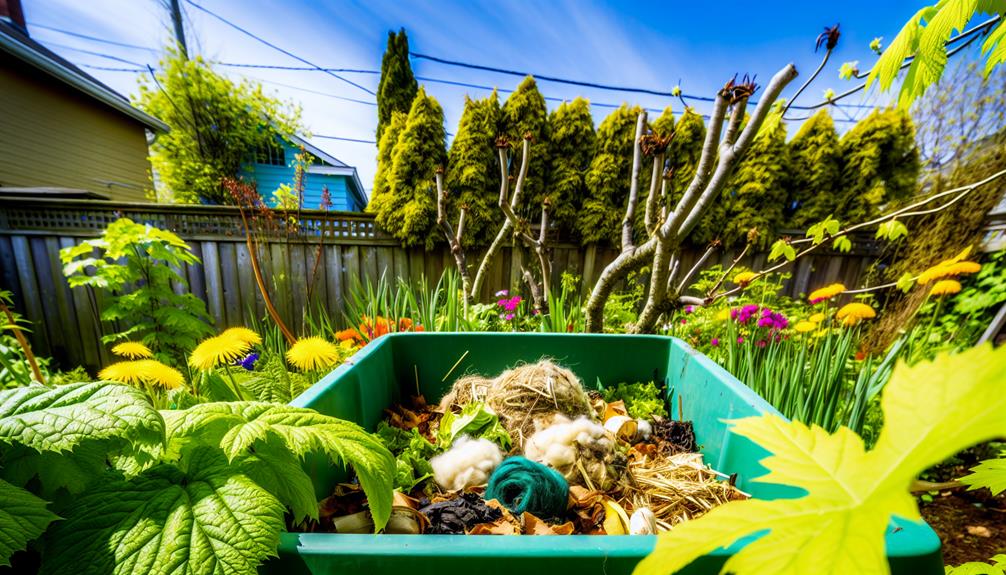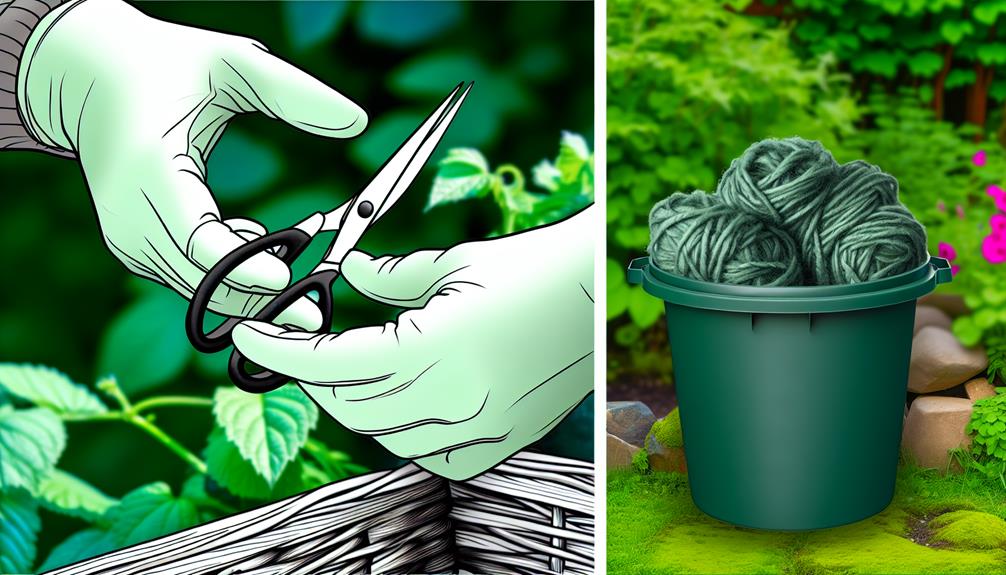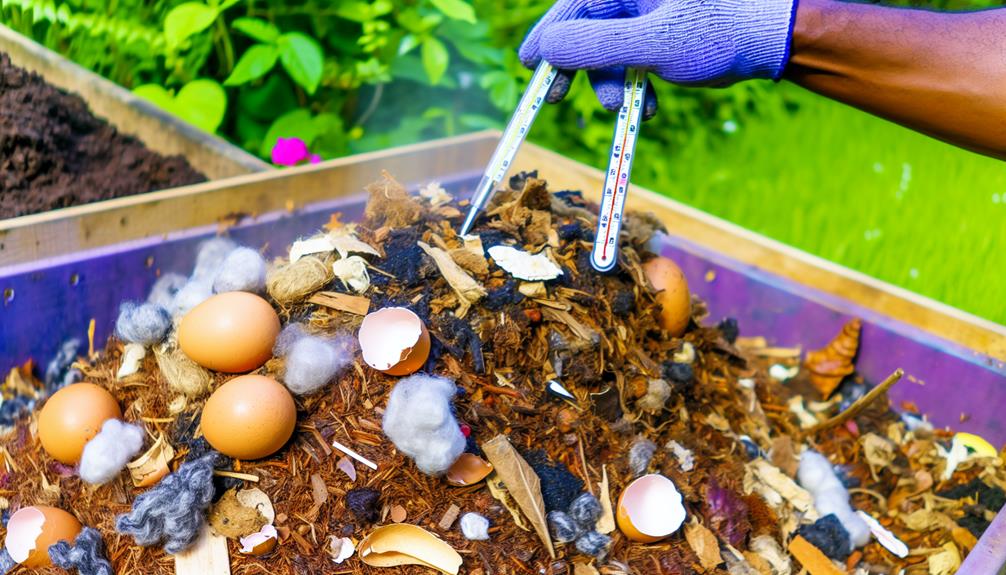

You can compost wool, which benefits soil health and reduces waste. Wool is rich in nitrogen, providing a steady nutrient supply for plants and improving water retention. Before composting, clean and cut the wool to speed up decomposition. Avoid synthetic materials and inspect for dyes. Maintain proper aeration and moisture by turning the pile and keeping it as damp as a wrung-out sponge.
Monitor the temperature to guarantee efficient breakdown. While challenging due to lanolin and structure, composted wool enriches the soil greatly over time. For deeper insights into composting, explore best practices and alternative uses for old wool.
Composting wool offers several environmental benefits that contribute to soil health and sustainability. When you incorporate wool into your compost, you’re not just reducing waste; you’re also enriching your soil. Wool is rich in nitrogen, which is essential for plant growth. As the wool breaks down, it releases nitrogen slowly, providing a steady nutrient supply that improves soil enrichment. This gradual release means your plants get the nutrients they need over an extended period, fostering healthier growth.
Wool also excels at improving water retention in soil. When mixed with compost, wool fibers help retain moisture, reducing the need for frequent watering. This is especially important in drought-prone areas where water conservation is key. The wool fibers act like sponges, holding onto water and releasing it as needed by the plants. This not only helps in maintaining a consistent moisture level but also supports the microbial activity essential for healthy soil.
To get started, simply chop the wool into smaller pieces before adding it to your compost pile. By doing so, you ensure it breaks down more efficiently, delivering all these fantastic benefits to your garden.
Also Read: Can You Compost Black-Eyed Peas?
Despite its benefits, you might encounter several challenges when trying to compost wool. One of the primary issues is the presence of wool pesticides. Many wool products are treated with chemicals to protect against pests, which can hinder the composting process. These pesticides mightn’t break down easily, potentially contaminating your compost and affecting the health of your garden.
Another challenge is the breakdown of lanolin, a natural wax found in wool. Lanolin is water-resistant and can slow down the decomposition process. While beneficial to the wool’s natural properties, it makes composting more complicated. You’ll need to guarantee proper conditions, such as sufficient aeration and moisture, to help break down the lanolin effectively.
Wool’s dense structure also poses a problem. It can mat together, creating barriers that prevent air and moisture from reaching the inner layers, slowing decomposition. To combat this, you can cut the wool into smaller pieces before adding it to your compost bin.
To prepare wool for composting, you’ll need to clean and cut it first. Make sure to remove any synthetic materials that may be mixed in.

Shredding the wool can also help speed up its decomposition process.
Before you toss wool into your compost bin, you’ll need to clean and cut it properly to make sure it breaks down efficiently. Wool preparation starts with removing dirt, oils, and any other residues. Simple cleaning methods like soaking it in warm water with a mild detergent can work wonders. Rinse thoroughly to remove all soap, and then let it dry completely.
Once the wool is clean, it’s time to cut it into smaller pieces. This step is important because smaller pieces decompose faster, making your composting process more efficient. Use sharp scissors or a rotary cutter to make this task easier.
Here are some quick steps to prepare your wool:
After cleaning and cutting the wool, you’ll need to eliminate any synthetic materials to guarantee it composts properly. Start by checking for synthetic dyes. These can often be identified by their bright, uniform colors that don’t appear in natural wool. If you’re unsure, perform a burn test: natural wool will burn slowly and leave a brittle ash, while synthetics will melt and form hard beads.
Next, inspect the wool for any polyester blends. This is important because polyester doesn’t break down in compost. Look for labels or perform a tactile test—polyester blends often feel smoother and more slippery than pure wool. If you find any blends, separate them from the wool intended for composting.
You’ll also want to remove any stitching or tags made from synthetic materials. These small pieces can easily be overlooked but will hinder the composting process. Carefully cut them out with scissors.
Shredding the wool into smaller pieces accelerates the decomposition process, allowing the material to break down more efficiently in your compost pile. When wool remains in large chunks, it takes a lot longer to decompose. By shredding it, you increase the surface area, which helps microbes and other decomposers do their work faster.
To get started, you’ll need shredding tools. Scissors or a rotary cutter can work for smaller amounts, while a fabric shredder might be more suitable for larger quantities. Once shredded, mix the wool thoroughly with other compost materials to make sure even decomposition. Here are some tips to keep in mind:
These steps will help you compost wool more effectively, creating rich, fertile soil for your garden. By preparing wool properly, you contribute to a more sustainable and connected community.
Also Read: Can You Compost Black-Eyed Peas?
To compost wool effectively, you’ll need to balance carbon and nitrogen materials in your pile. Mix wool with organic waste like vegetable scraps and yard trimmings to create a balanced compost.
Make sure you maintain the right proportions to speed up the decomposition process.
Balancing carbon and nitrogen is essential when composting wool, so you’ll need to mix it with other materials to achieve the right ratio. Wool is rich in carbon, making it a great addition to your compost pile, but it needs to be balanced with nitrogen-rich materials. This balance is pivotal for creating a nutrient-rich soil amendment and supporting your eco-friendly practices.
To achieve the right mix, consider these steps:
When mixing wool with other organic waste, make sure you’re combining it with nitrogen-rich materials for best composting. Wool is high in carbon, so pairing it with kitchen scraps, fresh grass clippings, or manure helps balance your compost pile. This combination accelerates wool biodegradation, ensuring it breaks down efficiently.
To start, cut the wool into smaller pieces. This increases the surface area for microorganisms to work on, speeding up the process. Layer the wool with your nitrogen-rich materials, creating a mix that’s roughly two-thirds green (nitrogen) to one-third brown (carbon).
Turn your compost pile regularly to maintain aeration and promote even decomposition.
Wool biodegradation in a compost pile is much more eco-friendly than letting it sit in a landfill. In landfills, wool decomposes anaerobically, producing methane, a potent greenhouse gas. By composting wool, you help reduce landfill impact and return valuable nutrients to the soil, enriching your garden.
Also Read: Can You Compost Celery?
Monitoring your compost pile’s health guarantees it breaks down efficiently and remains odor-free. Proper temperature management and moisture levels are essential. Aim for a temperature between 135°F and 160°F to guarantee effective decomposition. Use a compost thermometer to check the temperature regularly. If it drops below 110°F, turn the pile to reintroduce oxygen and boost microbial activity.

Moisture levels should be similar to a wrung-out sponge: damp but not soaked. Too much moisture can lead to anaerobic conditions, causing unpleasant odors, while too little can slow down decomposition. Adjust moisture by adding dry materials like straw or wet materials like vegetable scraps as needed.
To keep your compost pile in top shape, consider these key practices:
Also Read: Can You Compost Basil?
If your compost pile is thriving, you might wonder what else you can do with old wool besides composting it. One excellent option is upcycling projects. Wool is a versatile material and can be repurposed into a variety of new items.
For instance, you can create cozy throw pillows, stylish wall hangings, or even braided rugs. These projects not only give new life to old wool but also add a personal touch to your home decor.
Another practical use for old wool is wool insulation. Wool is a natural insulator, making it a great option for keeping your home warm. You can use it to insulate walls, attics, or even your garden shed. It’s environmentally friendly and often more effective than synthetic alternatives.
Simply clean the wool, remove any debris, and layer it where insulation is needed.
You’re asking about the wool biodegradation process. It usually takes six months to two years for wool to break down in a compost pile. The composting timeframe depends on factors like moisture, temperature, and pile management.
You might wonder if dyed wool can be composted safely. It’s tricky because dye toxicity can lead to chemical runoff. It’s best to verify the dye’s composition to make sure it’s eco-friendly before adding it to your compost.
Environmental factors like moisture levels and temperature variations play a huge role in wool composting. You’ll need to guarantee consistent moisture and ideal temperatures to help wool break down effectively, fostering a communal effort towards sustainability.
You don’t have to shred wool before composting, but using shredding tools and techniques can speed up the process. By doing so, you’ll help it break down faster, making you an eco-friendly hero in your community.
You can’t compost wool blends with synthetic fibers effectively. Synthetic decomposition is slow, and fiber separation is challenging. Stick to pure wool. You’ll help your community produce richer compost and feel connected to sustainable practices.
To compost wool effectively, make sure you cut it into small pieces and mix it with nitrogen-rich materials. Regularly turn your compost pile to maintain aeration and monitor moisture levels to prevent it from becoming too dry or too soggy.
Wool’s natural fibers will break down slowly, enriching your compost with valuable nutrients. If composting wool seems too challenging, consider repurposing it for insulation or crafting projects. With proper care, wool can be a sustainable addition to your composting routine.
